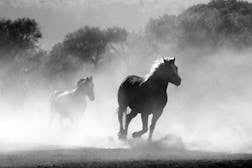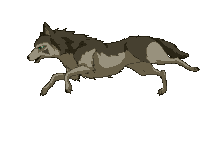Welcome to my new adoptable: Maned Storm Drafts! This is an open species, so we are always looking forward to new members! Most MSDs up for adopt are foals and yearlings that will be grown by their artists after the allotted time, but some can be adopted as adults.
What are Maned Storm Drafts?
Maned Storm Drafts (also called MSDs) have mysterious origins, but what they produce is anything but. These large draft horses work in herds to produce the storms that have plagued the skies since the dawn of time. They are at least as intelligent as humans and have their own language, but a radically different society in which they live in the wild. Physically, they resemble large draft horses with a somewhat canine pelt and anatomy, with a stiff, fluffy mane and tail and a thick wolfish pelt that shields them from the cold and the damp of the condensed water of the clouds. Their colors and patterns vary, but mainly are similar to the colors and patterns of horses and wolves. Maned Storm Drafts have large, sharp eyes and long fur, especially on the chest, neck, cheeks, and ankles. When they produce storms, they do so by magic produced at will. They have always made storms due to the fact that they feel on the physical energy produced by thunder and lightning. Maned Storm Drafts are not easily tamed or caught, and people rarely attempt to- they resemble the greek myths of the equine storm spirits, and most likely such myths were formed off of seeing them. They are intelligent enough to accept shelter and medical assistance from humans when they need it, however, and may welcome you into their herd. Will you accept their invitation?
Basic Physical Traits
Maned Storm Drafts are large, slightly larger than an average draft horse. Their legs are long and they have lean bodies and fine, angular features; however, this is usually covered by their thick pelt of fluffy, wolfish fur. Their fur is especially thick on their chest and front of the neck, their cheeks, their ankles (appearing like they have the feathered hooves common with draft horses), and their hindquarters and back of their legs. Males are also especially fluffy on their chins and belly. MSD's manes and tails are horse hair but layered, soft, and somewhat feathery. The manes stick up much like a zebra's but lean slightly forward due to being not as stiff. They have large hooves and normal ears, though sometimes they can be slightly larger. Most MSDs have a gene that gives them an underbelly, so their bellies and chests would be a different color than the rest of their body. Also, all Maned Storm Drafts have a dipping on their manes and tails that darkens the tips of the hair, though in very rare cases on dark MSDs they can have lighter tipping.
Breeds
There are four different breeds of Maned Storm Drafts: Thunders, Rains, Clouds, and Lightnings. Each perform their part in the herd when creating storms.
- Thunder: This is the only breed that is mainly male, as well as the ones that blend in the most with regular horses- they have no strongly visible traits to differentiate them, as their power to create thunder only shows itself when they run or whinny. They normally are warmer colors, usually wolf colors and patterns but also commonly having horse colors and patterns. It is not rare for them to have slightly larger hooves. All MSDs have a band of lighter hair on the tips of their mane and the edges of their tail, but very rarely they have a darker band instead, and only on very light-colored MSDs.
- Rain: Rain MSD's are mainly female, and create rain by shaking it out of their main or tail or striking clouds with their hooves. They are normally cooler colors, and their fur is usually damp and has conspicuous raindrops dripping off of and weighing down their mane, tail, and fur. They normally have horse colors and patterns.
- Cloud: The second most common breed of MSDs are pretty equal in terms of gender, but are still slightly more commonly female. They have both wolf and horse colors and patterns, though usually are less distinct patterns than other breeds. They are the most common to have longer fur.
- Lightning: Lightning MSDs are strongly most common and are very conspicuous and unnatural, usually taking to hiding from humans due to their traits. They are balanced in gender. Unlike the other breeds, they do not have to have specifically horse or wold colors and patterns- they can have unnatural colors, though not very bright or neon. Their patterns can also be non-equine and non-canine, and even be based off of other things. They are the only MSDs that can have practically any patterns imaginable. Their manes, tails, hooves, and eyes often spark with lightning (which can be any number of shades of blue, white, yellow, and rarely purple) that is the source of their power of lightning. Touching a Lightning MSD without permission could electrocute you with the force of a lightning strike.
Mutations
There are numerous identified mutations in MSDs, but some others may show up in special circumstances.
- Wings: Wings are a fairly common mutation, especially in Lightning MSDs. They are usually feathered.
- Longer/Shorter/Curled Mane and/or Tail: It is an uncommon trait in all breeds except rain MSDs, in which they are less rare. If the mane is longer it will not stick up strait, and instead will curl to the side at the top of the regular mane hight and hang down on one side.
- Larger Hooves: This mutation only shows up in the Thunder breed and even then is uncommon.
- Longer Fur: Rare in all breeds except Rain, in which it is only very uncommon.
- Double Breed: Has the powers and traits of two breeds. This is very very rare and cannot result from breeding. This is only granted to staff customs, and even then only one is allowed per user. If a double breed MSD breeds, it will only pass down this mutation if it is breeding with another double breed of the same two breeds, and even there it is only a one in four chance. Any double breed offspring must be put up for adoption.
- Forever Foals: This mutation halts the growth process. It is rare in foals and even rarer in yearlings.
- Snowies: A snowy is a Rain MSD with a specific mutation that allows them to create snow instead of rain. They always have a white base and greyscale markings, but can be offwhite. A herd with a Snowy cannot have any regular Rain MSDs, but can have other Snowy MSDs. There are 2 very rare versions of Snowies: Hail and Sleet Snowies. They may be in any herd no matter if it has Snowy MSDs or Rain MSDs.
Lifestyle
As mentioned before, MSDs live in herds. Each herd has at least one member from each breed in order to fully create a storm. Herds without lightning or thunder can exist rarely, though, and produce small rainstorms that won't sustain the MSDs for very long. When this occurs, they must find a new herd soon unless they are male, in which they can become a Herdless Stallion (HS) and assist other herds as they wander until they can form their own herd or join one. In herds there is a small hierarchy: There is a Lead Stallion (LS) and Lead Mare (LM). The lead mare can only breed with the lead stallion, as they mate for life. However, the lead stallion acts as a stud for all the other mares in his herd and can have foals with them as well. A Non-leader Mare (NM) can mate with a herdless stallion and produce foals, but the foals are forced from the herd by the LS once born. These are called Tempest Foals (TF), and must be taken in by another herd or become a herdless stallion (if they are male). However, a NM can mate with a HS and bring him into the herd, in which he would stay as the lowest member of the hierarchy as a Lower Stallion (LS) but let any female foals remain in the herd. (A male foals may remain in the herd if he is a Forever Foal (FF)) They are mated for life and the new LS cannot produce foals with any but his mate.
Breeding and Growth Stages
There are three growth stages: Foal, Yearling, and Adult.
- Foals grow into yearlings after 2 months. Male foals are called colts, and female foals are called fillies. They have no markings, only their basic colors randomly shown on their coat. Forever foals are the exception to this; they have the distinct markings of an adult.
- Yearlings grow into adults after 1 month. They still have indefinite patterns, but the colors are localized on their body and form a the general shapes of their markings. They cannot breed but can 'date' other yearling MSDs within their herd somewhat like humans do. Yearlings who have dated another MSD can reduce the waiting period of mates when grown.
- Adults can live for an indefinite period of time without aging, as all breeds of MSDs have magic within them. They can also now become a lead mare or stallion and gain mates. MSDs mate for life and must be pair bonded (the human equivalent of boyfriends or girlfriends) for at least two months (if they dated for a month as yearlings they only have to be pair bonded for one month).
- There are multiple methods for MSDs to breed. A mated pair of lead MSDs can have foals at any time. A non-lead mare can breed with a herdless stallion that is up for breeding, with the lead stallion of her herd, or with her lower stallion mate (if she has one). Lead stallions can be bred infinitely with the mares in their herds, and all herdless stallions up for breeding will be available for breeding as well. If an owner wants their HS to be up for breeding they must specify, and if an owner of a LS only wants their MSD to breed with their mate they must alert the owners of any mares in their herd.
- Mates cannot have the same owner.
- Mixed-breed pairings produced the breeds of the lightning most commonly, then cloud, then rain, then thunder the rarest. Their colors and patterns must correspond with both their parents and their breed.
- There is usually 1-2 foals, very rarely 3.
- Owners of stallions only have claim to their stallion's foals if the stallion is mated or pair bonded to the mare he is breeding with.
- If 3 foals are born, one must be put up for adoption.
- Rejected foals and tempest foals are put up for adoption unless the dam of a male tempest foal decides to leave the herd with her colt and enter a new one with it.

















